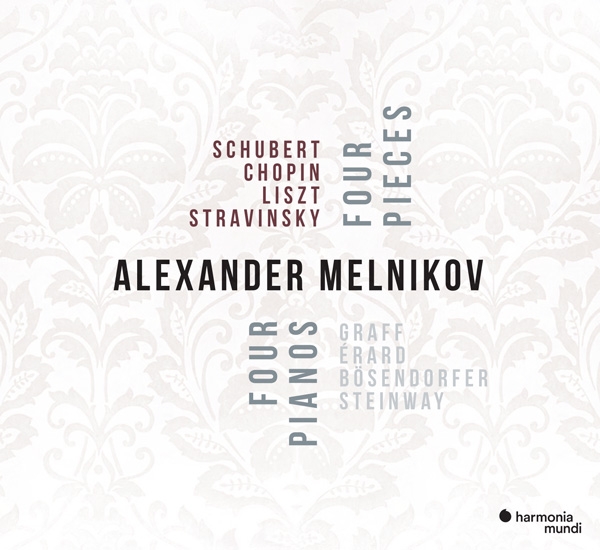| Columns Retired Columns & Blogs |
I immediately purchased some of this Artist's work.
Thank you
Tony in Michigan

For Schubert's astounding Wanderer-Fantasie D.760, Op.15, Melnikov chooses his own Alois Graff piano, made in Vienna ca 1828–1835. This unique instrument has leather covered hammer heads, a 6½octave keyboard, and five pedals capable of producing very different sounds. When its full potential is exploited by a genius such as Melnikov, its tones range from thunderous to extremely delicate. Its huge range of sounds and colors are an ear opener, and ideal for the great Wanderer.
Despite what initially seems to be a large dynamic range, this Graff is not particularly big-toned or overly resonant. This means that you turn up the volume for the Wanderer, unless you have a room much bigger than mine (16 x 20 x 9), you will quickly turn it down when you the final, big-boned piano in the two-disc set, a 2014 Steinway & Sons Model D-274, begins to tackle Stravinsky's delightful, rhythmically adroit, extremely dynamic Trois Mouvements de Pétrouchka.
As big and clear as that modern Steinway may sounds, it lacks the range of colors of the other, earlier instruments heard on the recording. Second to make an appearance, in Chopin's Douze Études Op.10, is the piano most suited to his music, an Érard produced in Paris in 1837. This instrument may date from roughly the same period as the Graff, but its sound is far more resonant and full. With hammers covered in felt, and a keyboard that spans 6¾ octaves, its top notes have a watery, chime-like quality that is instantly beguiling. Once you hear these Études sing on this instrument, you'll understand the sound that Chopin heard in his head as he composed, and then later replicated in performance."
For Liszt's Réminiscences de Don Juan, S.418, Melnikov chooses his own Bösendorfer piano from Vienna, ca 1875. With hammers covered with felt and leather on top, and a range of seven octaves, its symphonic resonance trumps everything else. This instrument produces so many colors simultaneously that Liszt's final "Champagne aria" variation from Mozart's don Giovanni becomes, in Melnikov's demonically fast interpretation, a virtual symphonic tour de force.
Melnikov writes of this instrument, in his detailed and deeply pondered album notes, "the advantages of the Viennese action (namely the tactile immediacy of the contact with the hammer, and hence the speed and agility of articular) tend to be cancelled out by a certain sluggish unpredictability, even clumsiness. Control of pianissimo and legato playing become rather tricky, and trying to play fast repeated notes normally leads to disaster. The piano is much less technologically advanced than anything Érard was already building back in the 1830s, but the mechanical properties of an instrument constitute only one side of the coin—in its sound the Bösendorfer retains the unique aesthetic of a true Viennese instrument, which was still very apparent to Johannes Brahms. In any event, interaction with this temperamental instrument is always extremely personal—for listener tuner and player alike."
That's another way of saying that you've likely not heard or played anything like it.
Piano-loving audiophiles, especially those who know some of the great classic interpretations of these works, will eat up this recording. It would be fascinating to learn how many listeners worldwide, regardless of audiophile pedigree, spend an afternoon comparing this Wanderer to Curzon's and recordings by other greats. Having heard Melnikov live on multiple occasions, one this is certain—his interpretations with fascinate and enthrall as much as the sounds of his very different instruments.

Another instant purchase- JVS!

Just found it on Tidal. I’ll be giving this a good listen soon. Your music recommendations open new doors for me. Thanks.

... Schubert performed by Brendel, the Chopin performed by Rubinstein, the Liszt performed by Wild and the Stravinsky performed by Gilels.


There's only one f in Graf
(you line 'em up, I'll knock 'em in)
I'm now off to Tidal to have a good listen to this, thanks.

is that I will never attempt to get a job as a proofreader. Then again, the dreaded, oft demonic duo of auto-correct and spell-check wouldn't last more than a day on the job.
Having said that, my spelling is correct. The fortepiano used for this recording was not made in the Vienna-based factory of Conrad Graf, but rather in the workshop of the lesser known Alois Graff.